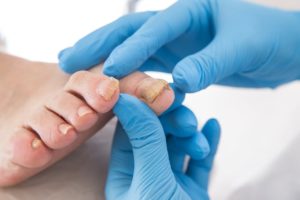Fungal infections in the toe nails can be unsightly and embarrassing and are very common. The correct term for the condition is Onychomycosis and is very difficult to eradicate. Fungal infections of the skin is often called Tinea or Athlete’s Foot. Often, the skin infection causes the nail infection and vice versa.
When nails are infected with a fungus, the nail tends to look yellow, white or black. Sometimes the nail raises and separates from the toe. Some nails become deformed and thickened and may develop into ingrown toe nails that are painful.

Most preparations people buy over the counter are expensive and do not work. We find that without a podiatrist cutting back the dead, fungal nail, improvement is limited.
It is particularly important for people with Diabetes to have their toe nails and skin checked. People with Diabetes are more likely to develop fungal infections and should address the problem at first sign of fungus.
Signs of fungal nails include: yellow, white or black colour, odd shaped, crumbly, raised or separated nail. They can also have a smell to them when you cut them back.
Signs of Tinea: itchy, red or flaky skin. Sometimes burning, pain or cracks between toes. Often little blisters are seen.
Your podiatrist can clinically diagnose fungal toe nails and skin but sometimes a toe nail clipping is required to be tested at Pathology. GPs often request that a podiatrist obtain the clipping as we can get the best sample of nail as we do this every day and have the appropriate sterile instruments.
If you are concerned about discoloured or chalky nails or itchy red skin, book a general podiatry assessment today.
No Referral Needed
Look After Your Feet!